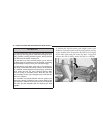
When sitting in this seating location, ensure the seatback
is fully engaged with the seatback latch by pushing
rearward on the center seatback until you hear a click
that signals latch engagement.
Automatic Locking Mode
To convert from the normal emergency locking mode to
the automatic locking mode, grasp the shoulder belt
portion and pull all of the webbing out of the retractor.
Allow some of the webbing to retract into the retractor, as
the belt retracts you will hear a clicking sound to indicate
the seat belt is now in the automatic locking mode. Once
the automatic locking mode has been activated, you will
not be able pull the webbing back out of the retractor. To
disengage the automatic locking mode, simply allow the
seat belt to retract fully into the retractor to return the seat
belt to the normal emergency locking mode.
Seat Belt Pretensioners
The seat belts for both front seating positions are
equipped with pretensioning devices that are designed to
remove any slack from the seat belt system in the event of
a collision. These devices improve the performance of the
seat belt by assuring that the belt is tight about the
occupant early in a collision. Pretensioners work for all
size occupants, including those in child restraints.
NOTE: These devices are not a substitute for proper seat
belt placement by the occupant. The seat belt still must be
worn snugly and positioned properly.
The pretensioners are triggered by the Occupant Re-
straint Controller (ORC). Like the airbags, the pretension-
ers are single use items. After a collision that is severe
enough to deploy the airbags and pretensioners, both
must be replaced.
THINGS TO KNOW BEFORE STARTING YOUR VEHICLE 35
2


















